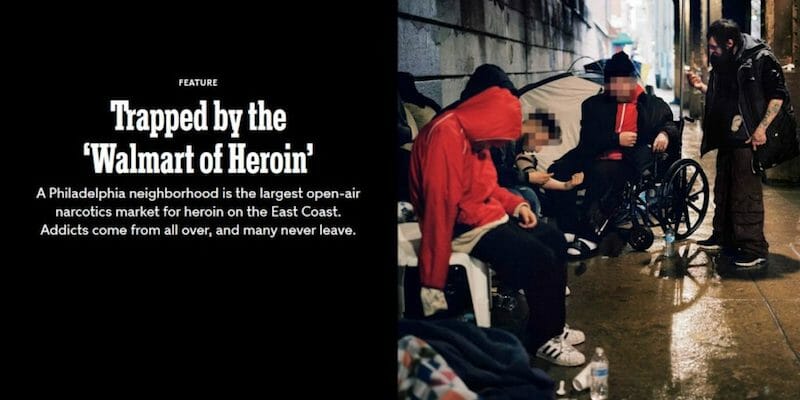New York Times’ Trauma Tourism in Philadelphia
The New York Times Magazine takes readers on a sensational 6,000-word tour of trauma, complete with cringe-worthy language and compassionless photographs. The article's photos feature easily identifiable people it describes as engaged in illegal activities. (FAIR)
The article's photos feature easily identifiable people it describes as engaged in illegal activities. (FAIR)
When The New York Times Magazine (10/10/18) looked at Kensington, a neighborhood in northeast Philadelphia, it didn’t see a diverse and resilient community that has tirelessly fought against adversity. Instead, it saw an opportunity to take readers on a sensational 6,000-word tour of trauma, complete with cringe-worthy language and compassionless photographs.
Reporter Jennifer Percy began the piece by painting a dismal and menacing backdrop:
The streetlights were broken or dim, and the alleyways were dark. Most of the blocks were lined with two-story rowhouses, abandoned factories and vacant lots. Kensington Avenue, the neighborhood’s main drag, was a congested mess of Chinese takeouts, pawn shops, check-cashing joints and Irish pubs.
Percy’s sour description of Kensington could fit almost any city: How many urban neighborhoods have brightly lit alleys? She tells you how to feel about a mix of businesses catering to working-class customers, associated with diverse ethnicities: It’s a “congested mess.”
This framing continued throughout the feature. At one point, Percy described the Kensington underpass as “dark, like the opening to a rat hole,” as if all underpasses aren’t dark. Even people who do something as simple as getting off the train in Kensington are reduced to “buyers”—“The train doors opened, and buyers spilled onto the walkway”—because Percy can’t imagine why anyone would go to Kensington other than to buy drugs.
The piece failed to differentiate between trash and the belongings of homeless individuals: “Trash was everywhere—office chairs, a pleather loveseat, plastic crates, trash bags stuffed with clothes.” Defining these belongings as nothing more than trash allows readers to be indifferent to Percy’s description of the city clearing out homeless encampments, seizing and throwing away people’s tents, clothes and supplies.
The Times doesn’t shy away from othering and stigmatizing people who do use drugs. (Percy wrote artlessly of one individual, “His eyes looked as if someone had scooped them out and filled them with mud.”) The piece reserved the word “residents” for those who lawfully live in Kensington’s houses and apartments. Anyone else, regardless of how long they have lived in Kensington, was just another homeless “addict.”
A recent revision of the AP Style Guide urged reporters to use “person-first language” when covering the drug issue, replacing the noun “addict” with “phrasing like he was addicted, people with heroin addiction or he used drugs” (Undark, 6/6/17). But in the Times piece, in every possible instance, such individuals were described as “addicts” or “users.”
Alex Shirreffs, a Philadelphia resident who has witnessed the effects of stigmatizing language through her work, reached out to the Times about their language use. In a tweet, she said she
asked them to consider style guide changes that would favor person-first language to describe addiction, but they seem to be sticking with the stigmatizing status quo because of…laziness?
Philip B. Corbett, the Times’ associate managing editor for standards, responded:
We do recognize the sensitivity of this topic and understand the arguments about words like “addict” and “alcoholic.” At the same time, as with many issues of language and terminology, we try to weigh the pros and cons of terminology favored by experts against the widely used and accepted layperson’s language. At this point, “addict” remains widely used among ordinary readers, and even some people who have addictions continue to use the term. On the other hand, I think that for now at least, “a person with a heroin addiction” and similar phrases would strike many readers as unfamiliar and strained.
It’s unclear why the Times thinks readers would be puzzled by a phrase like “a person with a heroin addiction,” and that dehumanizing language is the only way to convey to their audience that a person uses drugs. Researchers who have looked at the impact of such language on attitudes towards people who use drugs—based at the University of Pennsylvania in Philadelphia, as it happens—have urged people, especially those in the media, to “stop using ‘addict’ and ‘alcoholic’ when talking about people with substance-use disorders” (WHYY, 8/13/18). The research shows that these words generated both implicit and explicit bias against people who use drugs, while first person language helped eliminate bias. The Times’ choice to ignore this research actively hurts the Kensington community, as well as anyone who has an addiction.
Percy glossed over connections between drug use and sex work in Kensington, reducing an extremely complicated issue to trauma-porn.
People cycled in and out of Kensington’s recovery houses, treatment centers and shelters. After years of this, women often ended up as prostitutes. They offered oral sex for $25 so they could buy a few bags. They had been raped, tied up and held up. They had nowhere to go to shower. They feared telling the cops about the abuse because they had already been busted on drug or prostitution charges. They slept curled with their purses between their knees and their chests.
This short description is dehumanizing and gives no autonomy to sex workers as people, adding to stigma. How many women did Percy interview before determining that all of them offered the same services for the same price? Could she have crafted a description that was any more victimizing? Did she not think about the potential ramifications of this statement on Kensington’s street-based sex workers? Street-based sex work already comes with risks. Publishing detailed and intimate information about their services, and particularly about how they don’t report abuse, could attract predatory individuals.
Percy mentions that women who are abused while engaging in sex work are afraid to go to the police, but doesn’t explore this issue any further. Sex worker advocate groups and researchers have repeatedly said that criminalization forces workers into dangerous situations, and leads to a strained or even abusive relationship between law enforcement and sex workers. Multiple harm-reduction groups exist in Kensington specifically for sex workers, including SOL Collective, Project SAFE, and the Philadelphia Red Umbrella Alliance, but Percy didn’t think to include their work in the conversation.
Percy mentions that women who are abused while engaging in sex work are afraid to go to the police, but doesn’t explore this issue any further. Sex worker advocate groups and researchers have repeatedly said that criminalization forces workers into dangerous situations, and leads to a strained or even abusive relationship between law enforcement and sex workers. Multiple harm-reduction groups exist in Kensington specifically for sex workers, including SOL Collective, Project SAFE, and the Philadelphia Red Umbrella Alliance, but Percy didn’t think to include their work in the conversation.
Brooke Feldman, a community activist who was interviewed for and quoted in the Times article, said she was surprised and upset after reading the piece. She said her interview with Percy included a productive conversation about not sensationalizing the situation in Kensington, but that the final product ultimately did just that.
Feldman described the distrust that exists between advocates and journalists: “I have long been apprehensive about talking to media when it comes to stories about mental health and substance abuse,” she said. Philadelphia journalists had been working hard to report in ways that humanize and build relationships with communities. “There had been intentional efforts to foster relationships,” she said. Feldman felt that the Times piece deeply hurts these efforts.
Feldman was also disappointed that the many practical solutions being built by Kensington’s grassroots organizations were absent. “For those a part of the solution, [the article] did a disservice,” she said. After reading this piece, one would be forgiven for assuming that Philadelphia city officials have taken the lead in providing resources for Kensington’s struggling populations. Government officials are described as being the people on the ground trying to get people into treatment or provide access to services. Percy completely ignored the many non-governmental organizations that have been doing this work every day for years, well before the city declared Kensington a disaster area.
Prevention Point was mentioned once, and was described simply as a “nonprofit on Kensington Avenue that exchanged dirty needles for clean ones.” Prevention Point has also helped get hundreds of people into treatment in the past year, runs a homeless shelter, provides case management and help with legal services, teaches individuals and organizations how to administer Narcan and gives those who use drugs a safe place to exist. It has been instrumental in helping to guide the city’s efforts and making sure that people stay alive long enough to get treatment. The Times’ framing propped up the city’s official narrative, while ignoring the hard work of advocates and residents.
Feldman is concerned that the Times piece will only add to the stigma that much of corporate media has already generated. “Sensational stories cause harm and add to stigma, which is the number one barrier to people opening up and being willing to receive services,” she said. For those most impacted, dehumanizing reporting is deadly.
This massive reporting effort ultimately serves no one but the Times itself. It certainly doesn’t highlight any of the positive responses or harm reduction efforts happening in Kensington every day. All of the good that happens in Kensington was overlooked. The picture of Kensington that the Times has manufactured is bleak and hopeless, existing only to entertain readers to the detriment of struggling individuals.
Your support matters…Independent journalism is under threat and overshadowed by heavily funded mainstream media.
You can help level the playing field. Become a member.
Your tax-deductible contribution keeps us digging beneath the headlines to give you thought-provoking, investigative reporting and analysis that unearths what's really happening- without compromise.
Give today to support our courageous, independent journalists.









You need to be a supporter to comment.
There are currently no responses to this article.
Be the first to respond.